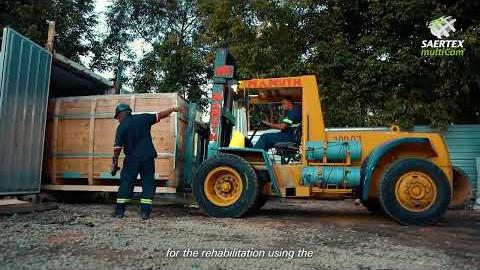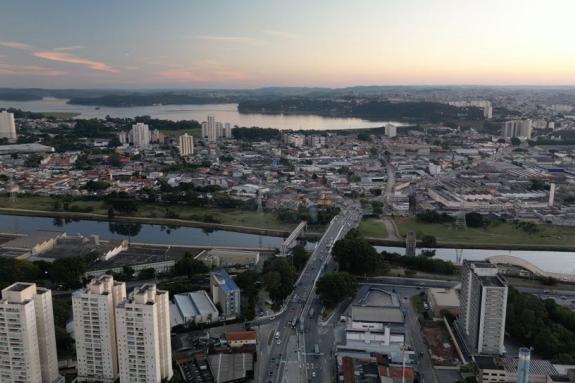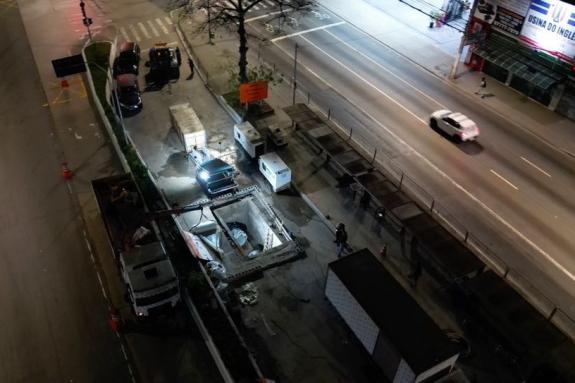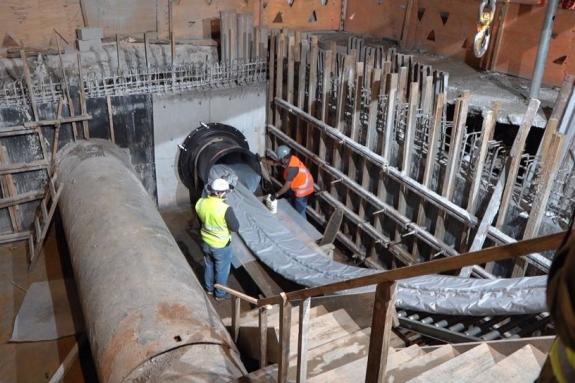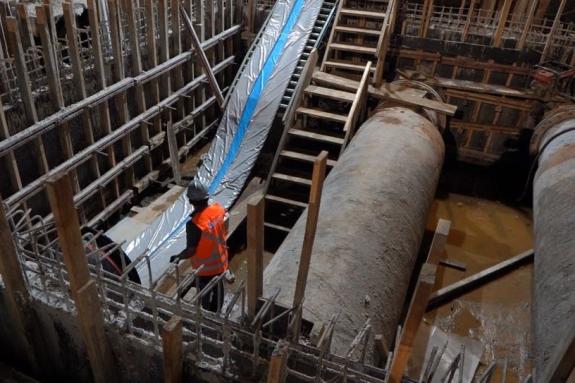Successfully rehabilitating a potable water supply line with the SAERTEX-LINER® H2O using the UV-CIPP process secured the potable water supply for some 900,000 families in Santo Amaro in June 2023. The 520-meter-long DN 873 potable water supply line requiring rehabilitation is located in a heavily trafficked area in Santo Amaro, a district of southern São Paulo.
Sabesp is the company responsible for the water supply and wastewater collection and treatment facilities in São Paulo’s 375 municipalities. In Santo Amaro, the main center in the south of São Paulo, a potable water supply line was rehabilitated in June 2023 in order to secure the supply of potable water to some 900,000 families on an ongoing basis. Santo Amaro is characterized by its garden allotments with special flowers and the Largo Treze de Maio area, where street vendors ply their trades. More recently, an ever increasing number of large offices and bank headquarters have also settled here.
To guarantee the continued supply of water to the large population of Santo Amaro, and in order to repair a major leak, it was necessary to rehabilitate an existing polyethylene potable water supply line with a nominal diameter of DN 873 and a length of 520 meters. This supply line had already been repaired eight years ago using the sliplining method, but a weld seam failure caused a new leak. In order to avoid losing water and prevent the potable water supply line from rupturing completely, further rehabilitation became unavoidable. This time, Sabesp attached great importance to finding a long-term solution to the problem. The pipe routing, right though the middle of a heavily trafficked mixed-use area, posed a particularly tough challenge for the rehabilitation project. The intention was for the construction work to have the least possible impact on residents, the existing infrastructure and road traffic.
Decision to Use the UV-CIPP Process
Right at the start of the project, network operator Sabesp analyzed the potential rehabilitation technologies together with teams of experts and came to the conclusion that trenchless rehabilitation was the best possible choice. Open construction was ruled out because it would have severely affected the surrounding area in multiple ways. It would have made tearing up the streets and sidewalks unavoidable, giving rise to huge traffic disruption and high levels of both dirt and noise. A further key concern in deciding on the right method was that the system consists of three potable water supply lines running in parallel. Since only the leaking line required rehabilitation, the other two lines needed to operate at full capacity in order to deliver the required volume of water to the region, even as the works were being performed. If one of the other potable water supply lines had been damaged or, in the worst case scenario, failed completely, Santo Amaro would not have received an adequate supply of water. This made rehabilitation in the shortest possible time – and with minimal environmental impact – a critical success factor for the project.
Good Planning Is Half the Battle
The contract for the project was awarded to Brazilian company Sanit Engenharia, which specializes in trenchless pipe rehabilitation using the SAERTEX-LINER H2O from SAERTEX multiCom. This product is approved in over 14 countries worldwide and has already been successfully used in more than 400 installations. The SAERTEX-LINER H2O enables the benefits of the trenchless cured-in-place pipeline rehabilitation method to be transferred to pressure pipelines too. This tight-fitting, self-contained GFRP pipe liner absorbs internal and external loads, withstands pressures of up to 33 bar, and is certified to Class A (DIN EN ISO 11295) and to Class IV (AWWA M28). In addition to delivering an economical and sustainable solution, the issue of project safety also played a decisive role in this installation. Ultimately, the leak in the pipeline placed the entire team under significant time pressure to successfully contain the resulting water losses and prevent the risk of the pipeline actually rupturing due to the leak. Many experts from a range of organizations were involved in the planning as this was an exceptionally complex project.
Felipe Montuori, SAERTEX multiCom’s Managing Director for the LATAM region was involved in the project from the initial planning stages through to its successful completion. His brief was to leverage his experience to execute the project in the most purposeful and economical manner possible. Back at the start of 2023, the project stakeholders had already commenced with intensive preparations for the works and entered into regular dialog with each other. It was already possible to clarify many questions and problems at this early stage of the project’s planning phase – good planning is ultimately half the battle.
This project enjoyed the particular advantage that the stakeholders had already successfully cooperated on completing other projects and that the company executing the work, Sanit Engenharia, also specializes in the trenchless rehabilitation of pressure pipelines. Felipe Montuori was able to complete the planning phase with a freshly trained team by holding training sessions on the entire rehabilitation process for network operator Sabesp’s technical team, and providing technical refresher courses for the Sanit Engenharia team.
Before work could commence on site, it was also important for all responsible parties to gain a comprehensive overview of the prevailing conditions along the course of the pipeline under rehabilitation. This included the terrain itself, the volume of traffic, the neighboring buildings and the available storage facilities. For this purpose, site inspections were carried out in advance with the client, contractor and suppliers all participating. This enabled the team to consider potential on-site challenges at an early stage and develop appropriate solutions.
Final Challenges Before Execution
The team first had to find suitable sites for the construction pits and make them as small as possible in order to have the least possible affect on traffic. The best possible pit locations were therefore determined. In so doing, the entire section under rehabilitation was divided into four, with lengths ranging from109 to 172 meters. To install the GFRP pipe liner, which is specially approved for use in potable water pipelines, five construction pits were excavated to a depth of over 6 meters in those defined parts of the section under rehabilitation. These gave the installation team access to the system and enabled them to perform all the necessary work. Especially as work commenced, the weather gods were rather unkind – heavy rainfall meant that the excavation work and draining of the construction pits took longer than planned. Optimum weather information was always available to the team because a meteorological organization was commissioned to provide daily up-to-date reports and forecasts.
It was possible to avoid transporting all of the construction site equipment over long distances, thanks to a storage location in the close vicinity. Moreover, the project team performed much of the work overnight. This delivered several advantages at once: lower impact on traffic and residents, protection against sunlight, and faster transportation of all equipment from the warehouse to the construction site at night.
In order to inform residents in a timely manner, the installation company distributed information flyers throughout the neighborhood in advance. Furthermore, all transport authorities, bus companies and local media outlets were informed. Signs were erected on the streets for the duration of the work to make all road users aware of the construction site.
Traffic restrictions were ultimately minimal. It was only necessary to redirect a bus route in one section and temporarily close a bus stop to allow rehabilitation work on the potable water supply line to be performed.
The Successful Installation
Installation of the four SAERTEX-LINERS H2O in Santo Amaro was performed by Sanit Engenharia’s experienced installation team. Felipe Montuori was also on site to assist with a variety of project steps during the rehabilitation of the four construction sections.
A Summary of the Key Installation Steps:
- Preparation of the old pipe and visual inspection
- Pulling through the pipe liner pre-impregnated with resin
- Setting up and calibrating the liner
- Curing the liner with UV light
- Connecting the liner ends with a liner end seal
- Quality assurance: Sampling, optical inspection and leak test
After pulling in the GFRP liner impregnated with styrene-free resin, it was cured with UV light. A major advantage of the UV-CIPP process is that all process parameters are under continuous digital control throughout the entire curing process. Cameras and sensors integrated at the UV light source provide real-time data to the control center in the rehabilitation vehicle on site. This enables the highest degree of process reliability.
Restoration of the Potable Water Supply
The professional and pressure-tight transition between the SAERTEX-LINER H2O and the old pipe was carried out using CipJoints from Nova Siria and liner end seals from Amex Sanivar. This makes the system capable of withstanding the maximum operating pressure – in this case 6 bar – over the long term with no problems. Finally, the pressure test was successfully completed and nothing stood in the way of restarting the potable water supply to this section of the pipeline in Santo Amaro.
Overall, the team can reflect on six intensive months at project completion:
- Three months for planning
- Two months for excavation work, all preparatory work and international logistics
- One month for on-site execution
“I would particularly like to highlight the longest section of 172 meters, where the curing time took just over seven hours. We were able to complete the entire section in just 18 hours. This includes all of the work stages such as signage, traffic diversions, transportation of materials and equipment to the construction site, setting up the construction site, cleaning the old pipe, CCTV inspection, installing the SAERTEX-LINER H2O and connecting the liner ends,” explains Felipe Montuori, emphasizing the enormous time savings offered by the UV-CIPP process.
A further decisive factor leading to the successful completion of the rehabilitation project was the excellent cooperation and know-how of all parties involved in the project. They had already amassed many years of experience and training in the field of trenchless pipe rehabilitation of potable water pipelines.
Technology Offers Many Benefits – Approved in More than 14 Countries Worldwide
UV-cured GFRP pipe liners have established themselves over several decades in the trenchless wastewater pipeline rehabilitation segment. For some years now, they have also seen increasing use in the potable water sector. Hygienic, sustainable and reliable for project use – GFRP liners must meet the highest quality standards for the trenchless rehabilitation of potable water supply lines. Ultimately, they secure the potable water supply for many people. Potable water supply lines must meet requirements that go far beyond the scope of gravity pipelines. They must permanently withstand a nominal pressure of up to 16 bar and meet high hygienic standards.
The SAERTEX-LINER H2O is manufactured at SAERTEX multiCom’s headquarters in Saerbeck, Germany, where the plant is certified to the ISO 9001 and ISO 14001 Standards. There, glass fiber textile reinforcement materials are processed into the resin-impregnated GFRP pipe liners. The entire manufacturing process, from production of the dry goods to impregnation and storage, takes place under the tightest technical and hygienic standards to allow use in the potable water sector. For example, the SAERTEX-LINER H2O is now approved in over 14 countries – including Germany, the USA, Brazil and China – for use in potable water supply lines.
Technology Offers Many Benefits – Approved in More than 14 Countries Worldwide
Sustainable
Trenchless pipe rehabilitation using UV-cured GFRP pipe liners enables environmentally friendly rehabilitation of pipeline systems. Alongside reduced noise and minimized earthworks, trenchless pipeline rehabilitation produces up to 70 percent less CO2 than the open trench method. (GSTT no11, 2016, "Comparison...").
Cost Effective
Eliminating earthworks delivers immense cost and time savings. For example, the 172-meter-long section under rehabilitation in Santo Amaro was completed in just 18 hours.
Safe
UV-CIPP rehabilitation is a certified process for use in gravity and pressure pipeline applications. It enables the reliable restoration of operational safety, impermeability and stability, delivering an improvement in the condition of the entire pipeline section.
Low Impact
Trenchless rehabilitation has the lowest possible impact on the environment surrounding the construction site, because this technology causes only minor disruption to road traffic and only minor noise, dirt and odor nuisance. Moreover, it also allows the roots of adjacent trees to be preserved.
SAERTEX multiCom Authors
Felipe Montuori (Managing Director LATAM)
Daniel Almeida do Nascimento (Technical Sales LATAM)
Michelle Kammler (Global Marketing)
